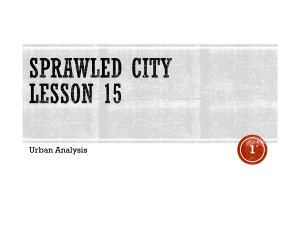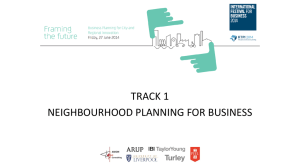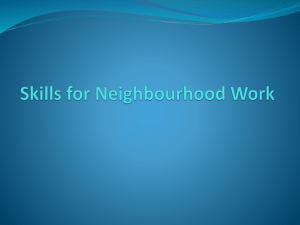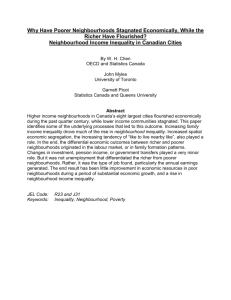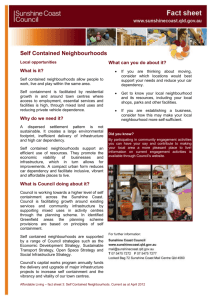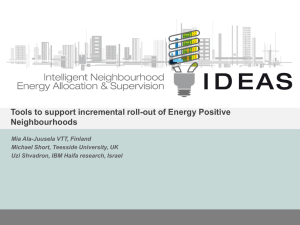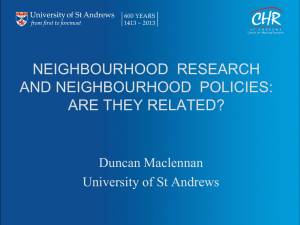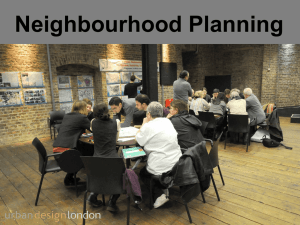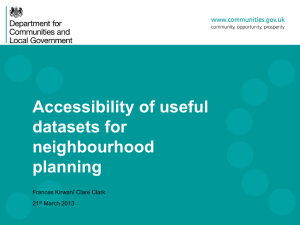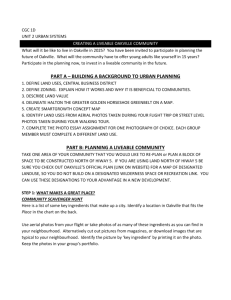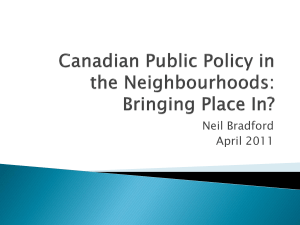Lecture 7 - Department of Urban And Regional Planning
advertisement
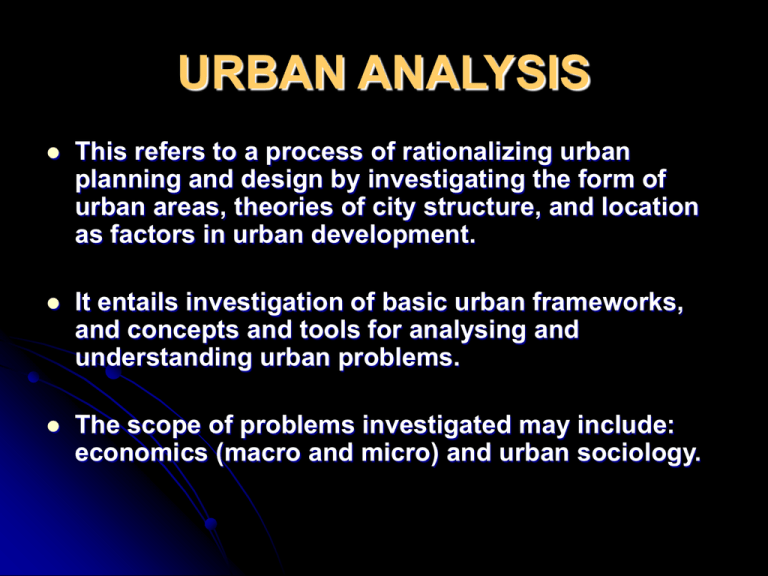
URBAN ANALYSIS This refers to a process of rationalizing urban planning and design by investigating the form of urban areas, theories of city structure, and location as factors in urban development. It entails investigation of basic urban frameworks, and concepts and tools for analysing and understanding urban problems. The scope of problems investigated may include: economics (macro and micro) and urban sociology. Urban analysis may apply the following methods/data sources: - - land use and density mapping; data gathering survey methods; geographic information systems; journal/library sources. Urban analysis is interested in a complex and multilayered understanding of the city… by building a conceptual framework that acknowledges that multiplicity through different pathways to sustainable development. These pathways often co-exist and function concurrently within a single city. Key Issues and Responses in Urban Analysis Urban Patterns/trends and their implications Zoning and the need for proximity Mobility/migration Compaction and the need for variety/richness of a place Suburbanization and the issue of urban sprawl Problems triggered by urban forms Unsustainable levels of resource use Inequitable lifestyles Ecological footprints: the catchment/amount of land necessarily affected to enable everyday life of a city; the nature & extent of effects of cities on land/environment. The concept of “Environmental Space” – a measure of the share of resources consumed by a city in a region or a country…… - a basis of calculating allowances for consumption and emissions (ref. Global environmental space calculation) The key responses : 1. Shift from singular to multiple models of a sustainable city Questions the over-reliance and emphasis on compact city model as a universal approach to achieving sustainability. Could constrain and blind efforts by researchers and policy-makers in searching sustainable urban futures. Variety in choice of urban form based on local situations….”MultipliCity”: a variety of approaches considered to suit particular settlement types….of different scales and locations. Consider alternative scenarios and incremental change as opposed to New Towns approach/wholesome change….consider constraints of space, cost, and acceptability. (ref. to pros and cons of the compact city model) 2. Rejection of simplistic use of models, instead develop competing pathways to sustainable cities Models not to be used as straightforward deterministic blue-prints to be translated into reality through physical planning and design policies in a series of linear stages Models to be used in a much softer, more flexible fashion: conceptual not specific; to sensitize on different visions to a sustainable city Models to consider views and strategies of different urban actors with competing social, political, and commercial interests. Actors views and strategies may resonate or dissonate with the visions of particular models of development Need to understand how the changing social organization of urban development may promote particular pathways towards distinct urban futures. 3. Co-existence of diverse sustainable urban futures within a single city charting the multiplicity of pathways towards different sustainable urban futures Examination of tensions and similarities between pathways: different social assumptions and biases Broadening the range of determining factors of sustainability of urban form: travel & fuel consumption; effects on ecology, wildlife, and natural resources; effects on social conditions and well-being e.t.c Adoption of inclusive approaches to avoid “islands” of success stories amid “seas” of failures. 4. Strengthening morphological studies Address size, mix of uses, block structures e.t.c Explore different scales of urban form – from the dwelling to neighbourhood, zone, district, city, and region Determine the key tangible and practical impacts of theoretical models…achievable in real terms. Urban analysis will herein be addressed under four components: Urban form - Structure Analysis Character Analysis Spatial Analysis Socio-spatial analysis Urban Form – Structure Analysis There are various classifications on this subject but generally all taxonomies touch on key issues: urban space efficiency; typologies of built form; transport and infrastructure efficiency; environmental efficiency; socio-economic and cultural considerations. Human Needs-Based criteria for Sustainable Urban Form 1 Need Defining characteristics Provision for all physical needs Place to live and work; reasonable income; education and training; training (mobility) and communication; access to services and facilities Human Needs-Based criteria for Sustainable Urban Form Need 2 Defining characteristics Safety, security and protection Visually and functionally ordered and controlled environment; a place free of pollution and noise; a place free of accidents and crime Human Needs-Based criteria for Sustainable Urban Form Need 3 Defining characteristics A conducive social environment Place where people have their roots and children have friends; sense of community and belonging Human Needs-Based criteria for Sustainable Urban Form Need 4 Defining characteristics Good image, reputation and prestige A place with a Sense of confidence and strength; a place with status and dignity; opportunities for individuals to shape their personal space Human Needs-Based criteria for Sustainable Urban Form Need 5 Defining characteristics A chance to be creative Opportunities for communities to shape their own neighbourhoods Human Needs-Based criteria for Sustainable Urban Form Need 6 Defining characteristics Aesthetically pleasing environment A place that is well designed (aesthetically pleasing); a place that is physically imageable; a city that is a place of culture and work of art Various models of urban form: This looks at the alternative shapes and structures of cities that could guide desired (sustainable) development. Analysis of urban form can broadly be divided into macro and micro scales. Macro-Urban Forms: The emphasis has mainly been on functional qualities that depend on overall form and development pattern of the city; Macro-urban forms (cont’d) They will address at a larger scale: different typologies of housing forms; good environmental conditions; access to open spaces for recreation and other functions; adaptability to changing needs and socio-economic conditions; access to country-side. To classify city forms on the above accounts will require accurate data on: overall densities total area required minimum and maximum distances, e.t.c The data is generated using different theoretical city models e.g input-output model. Evaluation of models is done based on criteria, standards, and performance values. The key macro-urban forms : Dispersed City: portrays continued low-density suburban development of population, housing, and jobs; infrastructure investment dominated by road development. Encourages urban sprawl and loss of prime agricultural and countryside land. Compact City: portrays increased population and density of an inner group of suburbs, with associated investment in public transport Edge City: portrays increased population, housing densities, and employment at selected nodes within the city; increased investment in orbital freeways linking the edge cities. Corridor City: focuses growth along linear corridord emanating from the central business district (CBD), supported by upgraded public transport infrastructure Fringe City: arises from additional growth predominantly on the fringe of the city. The above macro-forms translate into various identifiable geometries; these include: The core city/urban core The Star city/radial city The satellite city/Stellar pattern the Urban galaxy the Linear City the Polycentric City (ref. BUR 202 notes for definitions, merits and demerits of each of the above) Micro-urban forms: These are based on interrelationship of people, transport and amenities; they address the degree of user-friendliness in terms of mobility and access to services and facilities within walking and cycling distance and by public transport. Micro-urban forms cover a number of component areas: Various neighbourhood types, including digital Sustainable neighbourhoods, as envisioned in the Urban Villages Movement, seek to rediscover the balance between housing growth with the development of a strong and broad-based local economy. The main features include: The main features of sustainable neighborhoods include: A vibrant mix of uses: working areas; higher density housing; predominantly residential areas A hierarchy of open spaces: neighbourhood central square; pocket play parks; toddlers’ greens; riparian/canal corridors Integrated transport system: main bus/tram/light rail route; local bus route; neighbourhood street; local distributors; access roads Local facilities: shops; primary schools; places of worship; community facilities Various types of neighbourhoods include: Inner urban neighbourhoods: older suburbs with older housing stock, mostly done by local authorities Modern Suburbs: usually of mixed high- and low- rise development mostly undertaken by private developers/building societies or housing authorities e.g NHC. Urban Extensions: new neighbourhood areas currently planned on the edges of existing built-up areas. Brownfield Sites: Large sites of at least 20hectares in a single ownership where the building structures have been identified for clearing to pave way for new neighbourhood development. Mostly where the original use has ceased e.g disused railway yards. Digital villages address the needs of the society while taking advantage of advancement in Information and communication technologies (ICT) Neighbourhood Structure studies often address the following: Neighbourhood unit structure – overall, generalisation of key features Neighbourhood pattern e.g transit system; home-work distribution Neighbourhood Elements: Street pattern types Block types Infrastructure types: lot scale; block scale; neighbourhood scale Frontage types Building types Transects A transect is a system of classification deploying the rural-to-urban continuum to arrange in useful order the typical elements of urbanism. The elements may broadly be classified hierarchically as falling under: Urban core; urban centre; general urban; suburban; rural reserve; and rural preserve. Clusters: These are agglomerations of neighbourhoods integrated by shared infrastructure and amenities e.g public transport system; together they could form a regional urban centre. Cluster model favours high density areas. Townscape and city image Townscape refers to the collective view of the relationship of the elements that create the town environment: buildings, trees, cars, water, traffic, squares, advertisement and signage e.t.c… it is about optics, about places, and about content and their weaving to create the overall town image. Townscape is about underlying visual relationships that evoke a broad range of human response. Image of the city is the mental picture a person constructs of the parts of a town based on physical relationship between those parts….it a collective picture of what people extract from the physical reality of the town. …expressed in form of an “impression map” or “image map”. Use is made of basic elements as conceptualised by Kevin Lynch: path, edge, node, district, landmark (ref. BUR 202 notes) Performance evaluation criteria for urban form & structure Degree of containment of development Population density relative to land needed Viability of public transport Dispersal of vehicular traffic Viability of mixed uses Access to facilities and services Access to green open spaces Environmental conditions 9noise, pollution, congestion) Potential for local autonomy Potential for self sufficiency Degree of adaptability Imageability of the city (physical entity) as a whole Imageability of parts of the city (neighbourhoods, districts, towns) Sense of place and centrality
